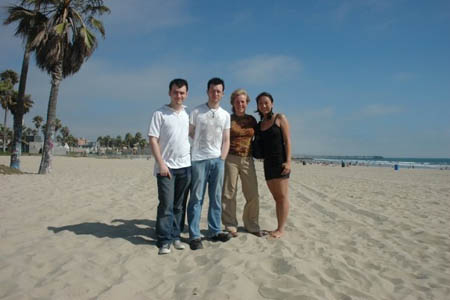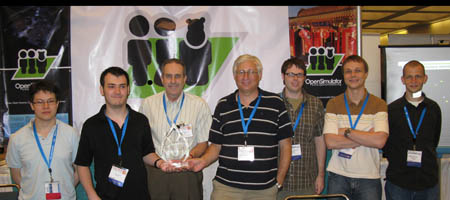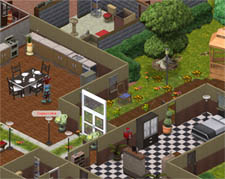OpenSim was in the spotlight at Virtual Worlds Conference and Expo, LA 2008. OpenSim won a conference Innovation Award and the OpenSim booth was a hub of activity.
At one time I saw conference attendees from Microsoft, Intel, and IBM all in conversation at the OpenSim table. A video of the OpenSim integration with Lotus SameTime was a centerpiece to Colin Pariss’, IBM, keynote interview with Erica Driver of Think Balm. And, just to back up what might seem my own seriously partisan opinion, I will note Wagner James Au made OpenSim the first of his top three picks from the conference for GigaOM
And, if you want to know why OpenSim is sizzling hot these days and you can manage some serious gearhead discussion here is an audio recording of our “Open Source, Interoperable Virtual Worlds” panel.
I was facilitator for a stellar group of virtual world uber geeks/phenom developers from OpenSim: Adam Frisby, OpenSim/SineWave, Mic Bowman, Intel, Justin Clark-Casey, Fashion Research Institute, Mike Mazur, 3Di and David Levine, IBM. See Dusan Writer’s blog for more on the heights of geekdom that were reached in the discussion, and for some interesting thoughts on the intersection of code, standards and social policy.
I open this post with a picture of Adam Frisby, Joshua Meadows, myself and Tess Linden enjoying some pre-conference Venice Beach time. Thanks Tess for showing us that you can be a phenom developer and get beach attire right!
But, the heart of our panel’s message was straightforward and powerful (yes I am obviously caught up in campaign season and on a message kick) . But in case you missed the LA Virtual Worlds conference here is the essence/message of our panel again, from my perspective, and in my words, and in short (relatively!!).
Open Source and Interoperability are the Basis for Innovation in Virtual Worlds.
This picture is from Adam Frisby’s blog of OpenSim “booth babes” with the Innovation Award. They were dubbed “booth babes” by Dusan Writer in counterpoint to David Levine’s comment on seeing this photo, “What a bunch of nerds!” David is in the center. And from the left Justin Clark-Casey (justincc), Adam Frisby (afrisby), Charles Krinke (ckrinke), David Levine (zha ewry), Adam Johnson (adjohn), Mike Mazur (mikem), Jeff Ames (chil1ken)
Basic building blocks and interoperability work will make Virtual Worlds part of the fabric of everyday computing
Big players like IBM and Intel are often asked why so much interest in OpenSim, in particular, when their goals obviously reach well beyond one platform. The answer to this, panelists explained, is that OpenSim is providing the best environment currently available to explore what will be the basic building blocks similar to http that will enable virtual worlds to emerge as a mainstream phenomena.
In conjunction with the open source Second Life viewer (despite the need for licensing changes and a new modular architecture which was discussed) OpenSim is the virtual world test kit supreme. The modular open source architecture allows for components to be disaggregated and reaggregated into new formations easily and rapidly. As I have mentioned before, Stefan Andersson, Tribal Media AB, has a catchy way of putting this, “OpenSim is a rapid prototyping testbench for wannabe paradigm shifters.” Stefan, one of OpenSim’s founders, notes this has been the heart of OpenSim from the start.
Interoperability work is the path to achieving virtual world standards
Achieving standards will take virtual world innovation mainstream. The innovation emerging from open source to produce basic building blocks, and the standards emerging from interoperability efforts, panelists explained, will be the magic brew that transform virtual worlds into part of the fabric of everyday computing. As Mic Bowman, Intel, describes it (interview upcoming in Ugotrade). The goal is that virtual worlds will ultimately be taken for granted much as when say “browse the web” – we take the “web” for granted (it is the applications YouTube, Flickr etc that gets our attention).
Our panel argued strongly that achieving virtual world standards will emerge from a combination of “rough consensus and working code” rather than “Vapor standards” – worked out by committees in the abstract. Both David Levine, IBM, and Adam Frisby noted “vapor standards” have been lost causes in the history of the internet.
Interoperability work allows for these basic building blocks of virtual worlds to be expressed across various computational fabrics which creates an environment for what David Levine describes as “parallel innovation.” David explains:
The point about parallel innovation is that there are several ways to evolve things. Open Source, tends to foster the addition of features, in common to the main trunk of development. Its very much about everyone building together. Sometimes, we need to or want to build stuff which works with that main trunk of development, but doesn’t share code, or has to fork. That’s where standards come into play.
While the OpenGrid beta has begun with Linden Lab and OpenSim, OpenGrid is just the beginning of much more extensive efforts to test and create protocols across different computational environments that will include increasingly different models of virtual worlds from OpenSim and LL’s model.
So another key message from our panel is: “Heterogenity fosters the creation of standards and more innovation.”
Metaplace and Second Life TM/OpenSim in Dialogue: Play Metaplace on a Prim!
One of the highlights of Virtual Worlds, 2008, LA, for me, was a forty minute conversation between Raph Koster, Tess Linden and myself about Metaplace (the pictures from the Metaplace blog are screenshots from worlds Metaplace testers have made.
I will have a more detailed post on this interesting dialogue soon. I think Raph illuminates some of the subtleties of what, Dusan Writer noted, came across as somewhat of a Metaplace v Linden Lab debate on the Future of Virtual Worlds panel. As Raph explained, one of the the things they like to say at Metaplace is that, “virtual places are going to be first class citizens of the web next to tags, audio, video, images….that’s a very different kind of picture of where this kind of stuff is headed” (see Raph’s comments on the panel here). But as a little warm up to more on Metaplace soon, here are some of the remarks Raph made about integrating OpenSim with Metaplace hehe!
If somebody took an OpenSim server and made it speak the tag language out. Then every Metaplace client would be able to talk to the OpenSim one. And visa versa, if OpenSim can open a bog standard gpt socket, because we don’t even use a binary protocol. We use absolutely bare bones of the web. If you can connect by telnet you can connect to Metaplace. So that means an OpenSim client could become a Metaplace client, parse the tags, and play them on a prim.
RealXtend bring a cool new demo to LA
In the picture above Ryan McDougall now senior software developer with RealXtend, Tomi Kujanpää (LudoCraft/realXtend Art Director & Avatar Specialist), Hannu Hollström (ADMINO technologies) have a drink with Gene Yoon (Ginsu Linden), VP of Business Affairs, Linden Lab at The Metaverse Mixer Meetup at the Hotel Figueroa. Cheers!
Kudos to Linden Lab for their big picture thinking demonstrated in the work they did open sourcing their viewer at a time when few other companies would have made such a move. And, more recently, for their efforts on interoperability with the OpenGrid initiative.
And, congratulations to RealXtend who have pushed the envelope on innovation with the open source Second Life TM viewer and OpenSim server this year. RealXtend showed up in LA with another awesome “undersea” demo that will be public on September 23rd (screenshot below from Ludocraft Ltd.)
Also more exciting news from RealXtend this week. Mac’s Virtual World reports:Â “OpenLife will be the first grid based on the OpenSim technology to use RealXTend features as far as I am aware of.”
Augmented Reality will bring Virtual Worlds out to the mainstream.
For an important look at how instead of more people going into virtual worlds, virtual worlds will be coming out to meet the people soon, see the Augmented Reality Panel video above. For more see Roo Reynolds and David Orban’s blogs.







September 10th, 2008 at 3:00 am
I’m pretty sure those pictures are from the Sims, not from Metaplace.
Ugo, look. They aren’t saying anything new they haven’t said at the last 6 panels in the last year or more. There isn’t the innovation. It’s not evident, regardless of all the ruckus kicked up. Why would some project basically reverse-engineering the Lindens’ SL be characterized as “innovative”? Innovative is what you get at Multiverse or some other company completely.
And there’s nothing to say that people screwing around on the test bench with Legos are the ones to whom we must look for standards. Standards don’t emerge from code in real life, they emerge when people — not code — managers of real companies with real stake — establish consensus on business requirements. When there’s a reason to connect through standards, they’ll connect, without people who have been playing in sandboxes with blocks.
In fact, this is merely another form of vapour standards — virtual worlds are very good at getting the people who make vapour standards into an immersive setting where they really imagine they are doing something.
And P.S. we don’t *want* them to teleport out of SL into other worlds with our stuff and our IP — because they don’t believe in making a permissions regime. Until there are overarching agreements in place about how c/m/t will be visibly implemented and work inworld, they shouldn’t be hastening. They are all about pipe, and all about connection, and not about content.
September 10th, 2008 at 7:59 am
Just a couple of points OpenSim is not reverse engineering LL servers. The relationship to LL server code would better be described as re-engineered.
And, re the relationship between the emergence of standards and code, what I said was that standards will emerge from “rough consensus and working code” Without people you cannot have something called “consensus” and, of course, people are writing the code too.
And, Linden Lab’s interoperability initiative with IBM comes from “managers of real companies with real stake.”
September 10th, 2008 at 1:32 pm
OMG Tish, you’re the ultimate OpenSim groupie! great work!
September 11th, 2008 at 4:56 am
Thank you for such a great blog. I agree with ‘admin’, Linden Labs close relationship with the OpenSimulator devs, and their willingness to support the OGP innitiative, demonstrate the importance of OpenSim to the biggest of the Virtual World businesses around today (Linden Labs). I think Prokofy’s view of ‘And P.S. we don’t *want* them to teleport out of SL into other worlds with our stuff and our IP — because they don’t believe in making a permissions regime’, is poorly researched (OpenSim devs are actively seeking to improve the permissions systems), and a demonstration of the fear of many of the SecondLife residents. SL is a bubble world, and will remain to be so (due to the closed nature of its economy and gameplay). OpenSim in no way want to burst this bubble, but rather they want to expand on the potential of such a truly great system. Standards in internet content delivery (http, css etc.) are there to provide a framework for content designers. OpenSim is a new framework, and I hope it will become standard for 3D content. If you are a talented content creator, you should be very excited by all this…the future potential for work will be huge, far greater than the closed world that is SL, businesses will be hiring content creators to work in-house, in the same way they hire web-designers now. I believe people like Prokofy are frightened, frightened the SL bubble may somehow burst, causing land prices in-world to tumble. Fear is a waste of energy, when you look into the future fear can be replaced by progression and development….Good luck OpenSimulator, and all future VWorld developments..and a huge thank you to LindenLabs and all the VWorld innovators that have forged the pathways and created the business so far.
September 11th, 2008 at 5:13 am
Oh..and those Metaplace screenshots are not from the Sims..(yr loosing it Prok.. )..check the Metaplace blog, I am pretty sure thats where these shots came from. (btw the Metaplace crew seem cool, they surf together (in the sea) and are coding a pretty cool world, although i think it is the world that falls somewhere between the 2D web, and the full blown 3D content that is the SL Clientside. Great for mobile phones and lower-spec PC’s).
)..check the Metaplace blog, I am pretty sure thats where these shots came from. (btw the Metaplace crew seem cool, they surf together (in the sea) and are coding a pretty cool world, although i think it is the world that falls somewhere between the 2D web, and the full blown 3D content that is the SL Clientside. Great for mobile phones and lower-spec PC’s).